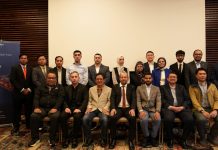Tech Mahindra recently appointed Ram Ramachandran as Senior Vice President and Head for Middle East & Africa. Under his leadership, the region has shown exceptional growth and today Tech Mahindra ranks amongst the largest IT service providers in the region.
Ramachandran has also been recognized by Forbes as a Top 100 Global Leader in Middle East for 4 years in succession (2015, 2016, 2017 & 2018) and Top 50 Indian Executives in the Arab World in 2018.
Business Live ME got on a call to know more about his recent appointment, his vision for the company, the way forward for Tech Mahindra in the Middle East, and key challenges in the market. Here are excerpts of the conversation:
Kindly tell us about your journey with Tech Mahindra. What is your vision for the company in this new role?
I have been with Tech Mahindra for 10 years. I joined in December 2009 after Satyam was acquired by Mahindra [April 2009] and moved from the US to Singapore to head the ASEAN business arm. As you know, it [Satyam scam] was an infamous event in the history of Indian technology. But the good that came of it is that for Tech Mahindra it was a great acquisition.
Tech Mahindra, before the acquisition of Satyam, was predominantly focused on the CME (Communication, Media, and Entertainment) business. After the acquisition, Mahindra Satyam became a more wholesome provider and from an organisation and shareholder perspective we have been able to grow the company by a factor of 5x. What started as a billion-dollar company, at the time of the acquisition, is now touching US$5.2 billion.
After having built the ASEAN business and running it successfully for five years, I had the option to move to the United Arab Emirates. So in early 2015, I moved to Dubai to take care of the then enterprise business of Tech Mahindra. And in the first quarter of this year, I have been given the charge for the CME line of business.
As a region, we are part of EMEA, which represents one-third of the organisation’s revenue. We are about US$1.5 billion in size, out of which MEA accounts for 20-25% of the business.
The idea now is to build up the business to even greater heights and move to the next stage of growth. We want to be a partner in our customers’ digital transformation journeys and enable smart, intelligent organisations. Our idea would be to position ourselves as a value adding partner in this digital transformation journey to enterprises who have an eye to the future. And my job is to ensure that we, as a team, enable that for our customers.
What is Tech Mahindra going to bet on both from a technology and industry perspective in the coming years?
The first paradigm that we are going to address in the market of tomorrow is the ability to create digital experiences for consumers and organisations.
Secondly, we are actively pursuing things around design experiences and how we design for the future and the customer value chain journey. We have been investing a lot in acquiring design firms; Two quarters back we acquired BORN, and before that we acquired legendary design house, Pininfarina.
The third is convergent experiences, which is an intelligent symphony of technology, platforms, and solutions for human experiences in a loosely coupled ecosystem.
On the technology side, we are going to bet very heavily on connected devices and the role of 5G as a technology, especially from a telecom provider perspective. We believe 5G will literally transform the industry … We are talking about factories of the future, Industrial IoT, transformation of Edge Computing, and more.
The second thing is the increased adoption of new technologies. For us the big bets are artificial intelligence, robotics, IoT, sensor-led 3D printing, Cloudification, [etc.]
And the third is exponential content consumption and how we can enable a huge amount of exponential content consumption and derive intelligence out of it through data analytics and predictive modelling based services.
Last but not least is change for our employees. Our biggest asset is our people. We want to make our people more relevant, more socially conscious and more driven towards digital journeys.
In Oman, we are a team of about 150-odd people and are planning a huge drive on Omanisation. Had COVID not come, you would have seen us make very fundamental announcements jointly with some of the prominent players in Oman towards providing services which will be more future-led. The ability to drive local talent development and growth is going to be very critical as we look into the future.
Read also: Mahindra University Outlines a New Paradigm for Higher Education in India
The Media and Entertainment industry in the Middle East has been hit hard. In what ways do you see the sector transforming in the “new normal”? What must they do today to rise up?
Every organisation that we are speaking to who has been a customer or a prospect is grappling with some very fundamental issues.
At a macro level, the challenge is cash-flow. The very basis of business or running operations is to ensure that the revenues constantly come in and that has been disturbed because of the on-going pandemic. The second, in our view, is disruption of supply chains. The third and most important change has been in customer behaviour and customer profile.
The strategic challenge would be how to accelerate the pace of being digital in the smallest tenure of time. It’s a tough one, but every organisation is re-looking and questioning how they would transform themselves into a digital organisation.
Luckily, technology provides for it, but how do you then get into the groove of running projects and programmes when your cash flows are hit? Can you choose a value-adding partner for you for that journey? And how ready are you within your organisation for that digital transformation journey?
The COVID-19 pandemic has accelerated the need for organisations to transform digitally. What are the key challenges do you see companies grappling with?
The digital transformation journey needs to flow from the top and clarity of vision has to come from the people who are leading the business.
Secondly – I wouldn’t call it a challenge, but an approach – is to have a confluence of a top down and bottom up approach intersecting with each other. So a top-down setting of vision, and a bottom-up ability to quickly bring in changes and transformation.
The third challenge is the culture of the organisation and how can it change to adapt to a new digital culture. It is something that is very difficult to change but a fundamental one nonetheless.
What, in your opinion, should the next steps be for any digital transformation program to remain relevant and help organisations navigate this crisis?
Going back to the drawing board and figuring out what should be the digital strategy. Digital strategy does not necessarily revolve around technology and that’s a mistake that we have seen organisations typically make. It is relooking at the way the customer buying behaviour and the customer pattern would change and then building a digital strategy around it.
How is it that we can service a customer better? How can we service the customer with zero-touch? How is it that we can still give him that experiential aspiration that he anyway looks from a product? It is not about rocking the whole boat. It’s about small, incremental changes.
The third step is, how do you find budgets for it? And this is becoming a Catch-22 situation for most organisations. Does this mean you need to revisit your partner strategy? Do you need to relook at a way of doing business by cutting down certain business lines?
These would be the fundamental two-three steps that any organisation needs to start thinking about.
From a Tech Mahindra perspective, we call it the Business Excellence Value Chain journey that we define for customers. We look at the portfolio of your services and then look at how we can free up budgets for running digital journeys.
What have you, on a personal level, learnt from this pandemic? Any takeaways that you would like to share?
I think on a very personal level [it would be] a very humble realisation of the fact how fragile life is. What was going so well yesterday is very different today. Another realisation is how much we have played with the ecosystem [and that] we should count our blessings. The very fact that we are getting to see the next day and hopefully looking at the more positive things is very heartening.
On the business side, the learning has been not to wait for an eventuality to happen. It has brought to light how important it is to have a contingency plan for every part of a business. It is important for organisations to be always thinking a step ahead and the ones that are going to survive and tide faster are the ones that have adapted.






